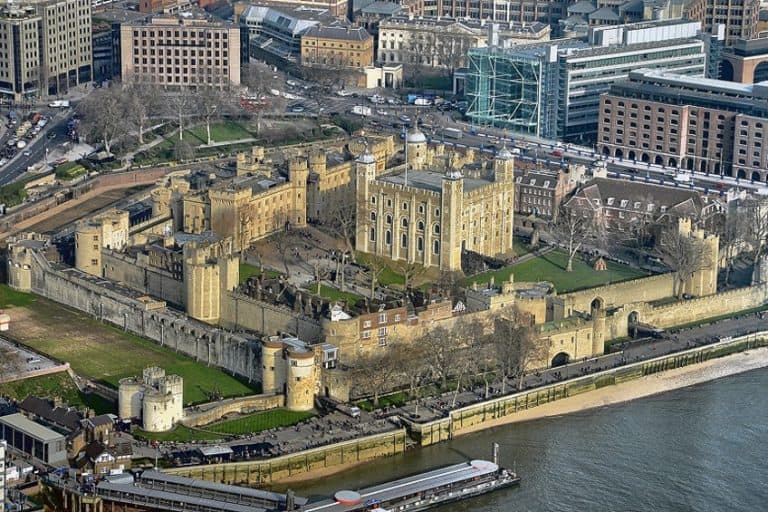Oldest Buildings in the World – A Glimpse into 15 Ancient Wonders
From the time early humans left the caves, they have needed to build structures to live in. The oldest man-made structures would have been created from the available materials in the environment such as mud, reeds, stones, rocks, and wood. But, what is the oldest building in the world still standing today? This article will explore the oldest buildings in the world, and answer common questions such as, “where is the oldest building in the world?”.
Exploring the Oldest Buildings in the World
What can the oldest structure in the world reveal to us about our past? This is the question that drives most archeologists in their search for the oldest man-made structures, such as the world’s oldest monuments, houses, places of worship, and public buildings. Many of the oldest buildings in the world are the only remnants of a bygone era, yet, studying them often leads to the accumulation of a wealth of information that serves to paint a clearer picture of what life was like thousands of years ago. Let’s start our search for the oldest structure in the world, starting with the 10th oldest man-made structure still around today.
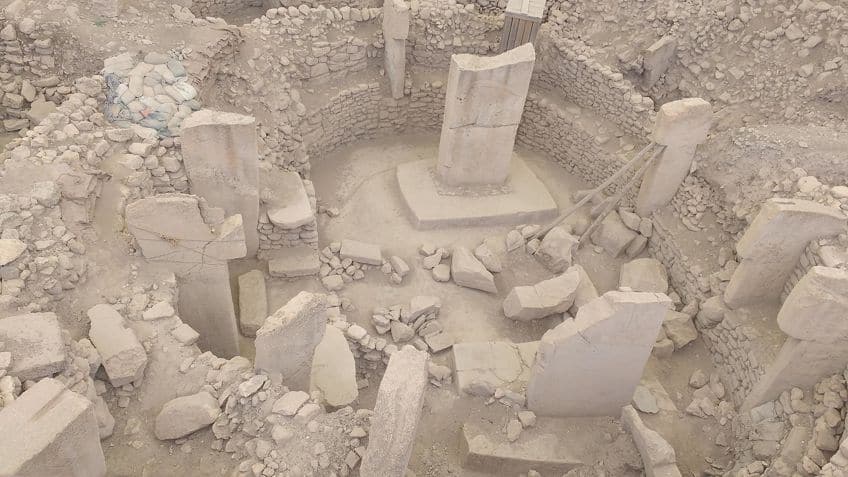
Tumulus of Bougon (c. 4800 BCE)
| Date of Construction | c. 4800 BCE |
| Period | Neolithic period |
| Function | Cemetery |
| Location | Bougon, France |
The Tumulus of Bougon is a Neolithic-era collection of barrows. This site is located in a village in the Nouvelle-Aquitaine region of western France known as Bougon. The Tumulus of Bougon was built during a 1200-year period and is thought to be one of the oldest known instances of megalithic building on the French Atlantic coast. Archaeologists discovered the cemetery in the 19th century and unearthed it throughout the following years.
Nowadays, this ancient site is open to the general public, and a museum barely a kilometer away exhibits archaeological artifacts from the site.
One of the notable aspects of this site is that each of the barrows is distinct and has a particular architectural style. Tumulus A, for instance, was discovered first in 1840. It comprises a stepped mound with a big rectangular room in the core. During the excavation, 220 corpses and burial artifacts were discovered. Several barrows at the site contain many chambers. Tumulus B is especially fascinating as it contains four different chambers. Tumulus C is among the more intricate mounds at the location, as it was constructed in multiple phases.
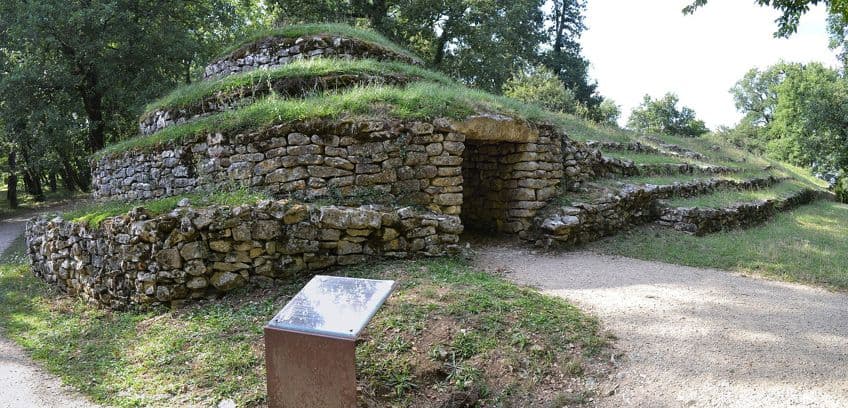
Cairn of Barnenez (c. 4800 BCE)
| Date of Construction | c. 4800 BCE |
| Period | Early Neolithic period |
| Function | Mausoleum |
| Location | Brittany, France |
The Cairn of Barnenez, among the world’s oldest man-made structures, is a Neolithic architectural marvel and Europe’s biggest mausoleum. What distinguishes this tumulus is that it was built completely of precisely placed stones, resulting in 11 burial chambers. It was constructed over two distinct phases, and the exact date of completion remains unknown. The first phase of the building’s construction, based on one source, lasted from around 4800 BCE to 4500 BCE, while the second phase started in 4200 BCE and concluded in 3900 BCE.
The sheer size of this ancient structure, irrespective of exactly when it was erected, is a tribute to the ability and tenacity of its creators.
The various buildings may be differentiated not only by their chronological phases but also by the materials utilized. The builders used the substantial dolerite available in the surrounding region during the initial phase, lending a bit of local character to their creations. The use of granite obtained from the neighboring Île de Sterec brought a new element in the second phase. Locals employed the Cairn of Barnenez as a quarry until the 1950s, resulting in partial exposure of several of the chambers. Since realizing the importance of the site, it has been excavated and restored.
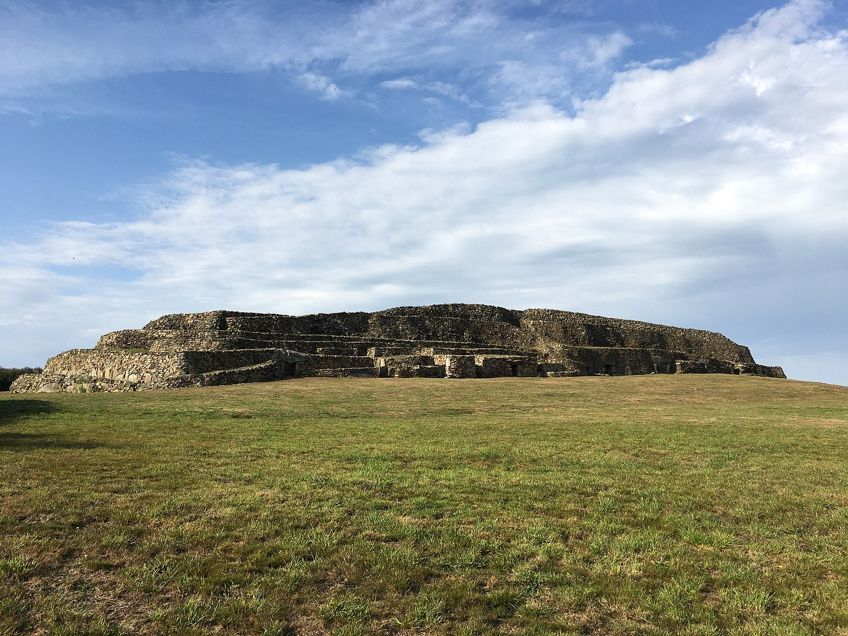
Perperikon (c. 5000 BCE)
| Date of Construction | c. 5000 BCE |
| Period | Early Neolithic period |
| Function | Sacred place |
| Location | Kardzhali, Bulgaria |
The region has been inhabited since 5000 BCE. The first signs of civilization on the hilltop originate from the Bronze Age, while the pottery discovered there belongs to the Early Iron Age, as does the remarkable circular altar sculpted out of the rocks. During the classical period, Perperikon is believed to have featured a magnificent Temple of Dionysus. Perperikon is the place from which Medokos proclaimed himself king of Thrace after Sitalces’ death in 424 BCE, but was deposed. In 2000, Bulgarian archaeologist Nikolay Ovcharov began excavations in Perperikon, revealing the ruins of an important historic complex.
Archaeologists discovered a massive multi-story palace and an enormous fortress erected around the hill, with walls up to 2.8 meters thick.
This was created during the reign of the Roman Empire. The castle also had temples and residential apartments. Throughout history, the megalithic edifice has fallen to ruin and been rebuilt several times. On the 10th of September, 2005, Bulgarian archeologists discovered a church pulpit at the summit of the Thracian rock sanctuary. It is believed to be the first discovered in Bulgaria and was most likely constructed around the end of the fourth century CE.
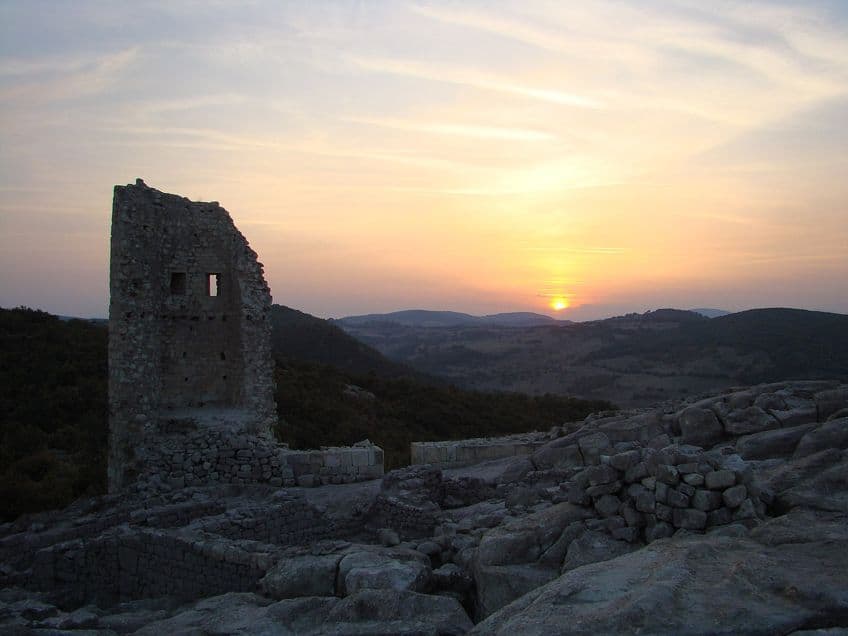
Durankulak (c. 5500 BCE)
| Date of Construction | c. 5500 BCE |
| Period | Neolithic period |
| Function | Settlement |
| Location | Golemija Ostrov (Big Island) in Durankulak lake, Bulgaria |
The Hamangia civilization was the earliest occupants of Dobrudja, and they were the first representation of Neolithic existence. The Hamangia were small-scale farmers and plant gatherers who constructed dwellings, produced ceramics, kept animals, and hunted them. In 4700 BCE, stone construction was widely used and became a distinctive phenomenon that was unique in Europe. The structure at Durankulak was a well-organized collection of large structures with many rooms.
They were built in a systematic arrangement that was replicated across succeeding generations of home constructions.
Structures were rectilinear, with long, narrow walkways between individual residences that stood alone or were next to other structures. Large wooden poles were lowered into foundation trenches and connected with planks of wood coated with clay or mud to construct the structures. Durankulak is one of the few monuments preserved from Europe’s early farming communities that inform us about daily life from that time period. Between 1974 and 1997, 1204 ancient burials were painstakingly documented at Durankulak, and the remnants of 21 dwellings were discovered.
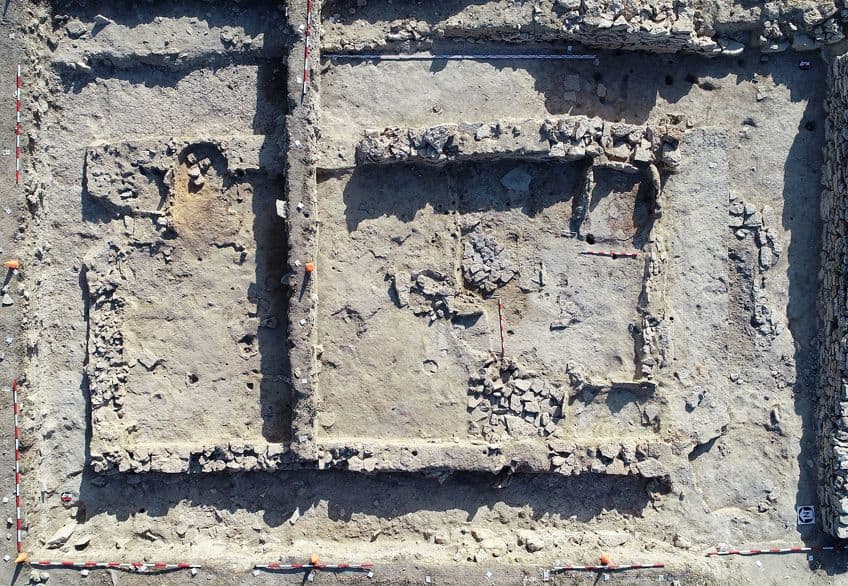
Khirokitia (c. 5800 BCE)
| Date of Construction | c. 5800 BCE |
| Period | Neolithic period |
| Function | Settlement |
| Location | Island of Cypress |
Khirokitia is a significant prehistoric site in the eastern Mediterranean. The site has barely been partially restored, and archaeological work still continues. Human existence in Khirokitia began approximately 7000 BCE, during the Neolithic period. It is unknown where the people came from and It is conceivable that the neolithic communities in Cyprus were the outcome of Middle Eastern colonization. The village’s population was most likely around 300 people. They worked in animal husbandry and agriculture and seldom lived longer than 35 years.
One of their most unusual rituals was burying their deceased beneath the flooring of their surviving relatives’ homes.
This way the dead could still be close to those still living. Each hut’s internal divisions were determined by its intended use. Work, relaxation, and storage spaces are demarcated by low walls and platforms. They had hearths, which were likely used for heating and cooking, seats, and windows, and there is an indication of piers to sustain an upper level in several cases. It is thought that the huts were similar to rooms, with many of them arranged around an open courtyard to create the residence.
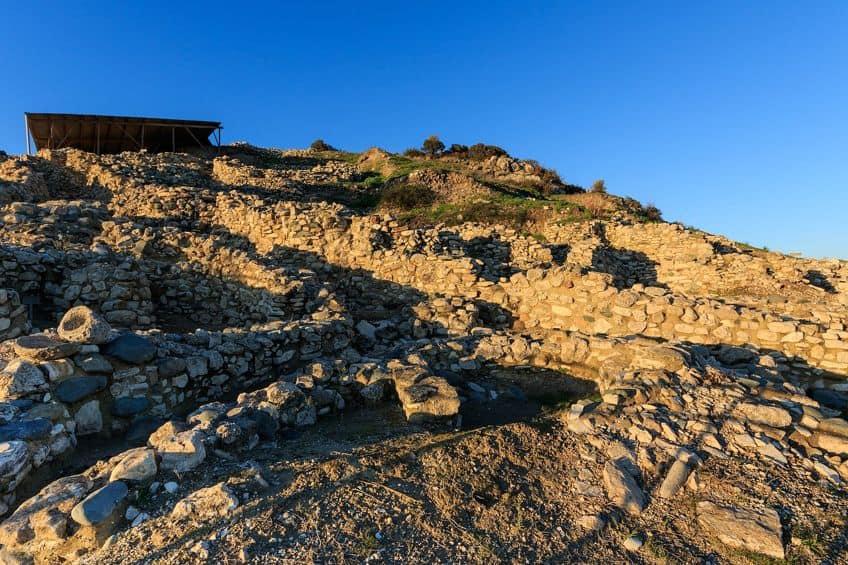
Çatalhöyük (c. 7400 BCE)
| Date of Construction | c. 7400 BCE |
| Period | Neolithic period |
| Function | Settlement |
| Location | Southern Turkey |
Çatalhöyük is neither the earliest nor biggest Neolithic site, but it is incredibly essential to the beginnings of art. It was occupied 9000 years ago by up to 8000 individuals who resided together in a huge settlement near the present-day city of Konya in south central Turkey. Çatalhöyük has witnessed the change from solely gathering and hunting for sustenance to increasing expertise in both animal and plant cultivation throughout its history.
We could consider Çatalhöyük to be a location whose story is about one of man’s most significant transitions: from wanderer to settler.
It is also a location where we encounter art, both sculpture, and painting, taking on new importance in the settler’s lives. It had no footpaths or streets; the dwellings were built close up against one another, and the individuals who resided in them walked over the town’s rooftops, descending down a ladder to enter their homes through openings in the roofs. Communal ovens were constructed above the residences, so we could suppose that communal activities took place in this raised location as well.
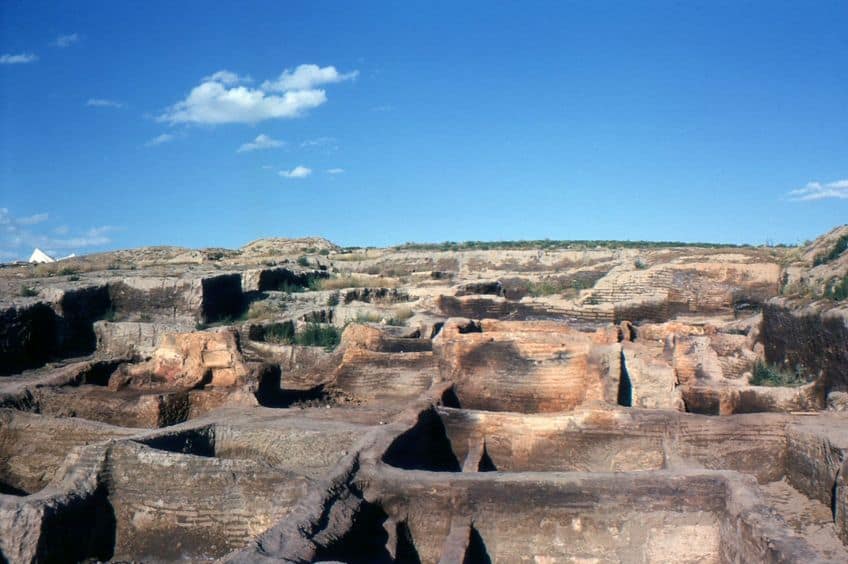
Mehrgarh (c. 7000 BCE)
| Date of Construction | c. 7000 BCE |
| Period | Neolithic period |
| Function | Herding and farming |
| Location | Balochistan, Pakistan |
Mehrgarh is a significant Neolithic site in modern-day Pakistan, situated at the base of the Bolan pass in the Kachi plain of Baluchistan. It is the oldest known Neolithic site in the northwestern Indian subcontinent, containing traces of agriculture (barley and wheat), herding (sheep, calves, and goats), and metalworking dating from around 7000 to 2600 BCE. Mehrgar is located on the main route between the Indus Valley and Afghanistan; this route was probably part of an early commerce connection between the Indian subcontinent and the Near East.
Between 7000 and 5500 BCE, Mehrgarh was a modest farming and pastoralist community with mud brick dwellings and granaries.
The early inhabitants made use of local copper ore, bitumen-lined basket containers, and a variety of bone tools. Domesticated and wild barley, emmer wheat, einkorn, wild Indian jujube, and date palms were among the plant foods consumed during this time period. The first Mehrgarh dwellings were standalone, multi-roomed rectangular structures made of long mortared mud bricks. These constructions are strikingly comparable to those of Pre pottery Neolithic hunter-gatherers in Mesopotamia’s early 7th millennium. Burials took place in brick-lined graves containing shells and turquoise beads.

Tell Qaramel (c. 9500 BCE)
| Date of Construction | c. 9500 BCE |
| Period | Neolithic period |
| Function | Settlement |
| Location | Aleppo, Syria |
Before the excavations started, it was presumed that stable sedentary settlements would emerge only in conjunction with the introduction of cereal farming along with the initial domestication of animals such as goats and sheep, heralding the beginning of the Neolithic era, as a period of changeover between the proto-Neolithic and Pre-Pottery Neolithic A cultures.
Nevertheless, the structures discovered at Tell Qaramel seem to be older, providing the earliest indication of a permanent stone-built village.
A survey conducted in the late 1970s discovered evidence of occupation at the site dating from the Pre-Pottery Neolithic A era to the Hellenistic period. The Tell’s mound is closely connected with the latter periods of habitation. Tell Qaramel is located in a lush river valley that has historically served as an important trading route; a railway still connects the present-day settlement with the tell, passing through the neolithic site.
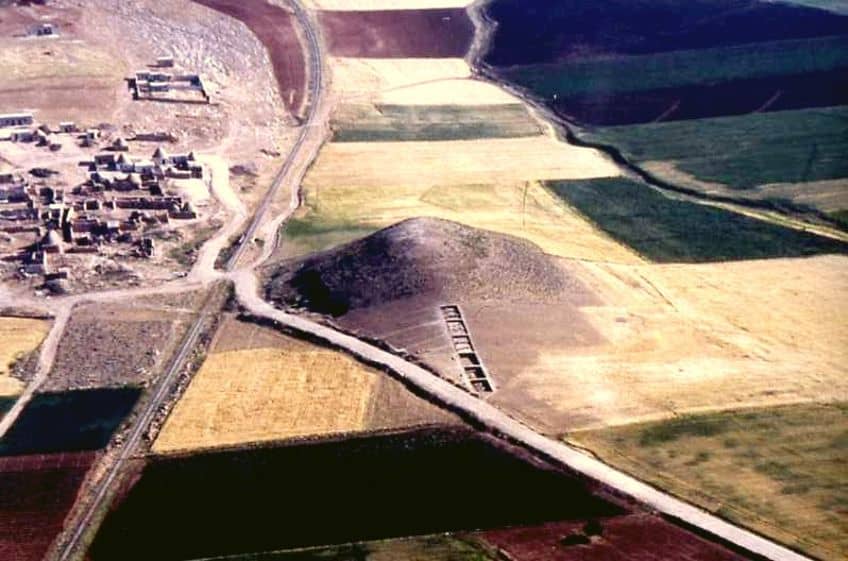
Tower of Jericho (c. 8000 BCE)
| Date of Construction | c. 8000 BCE |
| Period | Pre-Pottery Neolithic period |
| Function | Settlement |
| Location | West Bank, Palestine |
A 28-foot-high stone tower found on the outskirts of Jericho by archaeologists in 1952 has perplexed experts ever since. Tel Aviv University researchers at the ancient site Tel Jericho are unveiling fresh details about the “first skyscraper in the world” 11 millennia after it was erected. It is regarded as one of humanity’s oldest monuments made from stone. During excavations from 1930 to 1936, John Garstang discovered the Wall of Jericho, which he believed to be those mentioned in the Bible’s Book of Joshua and dated to around 1400 BCE.
During excavations in trench I between 1952 and 1958, Kathleen Kenyon uncovered the tower erected against the wall within the town.
Kenyon offered evidence that these buildings dated far earlier, to the Neolithic, which is the final stage of the Stone Age, and were a component of a proto-city. The tower emphasizes the significance of Jericho in understanding settlement patterns throughout the Sultanian era in the southern Levant. The tower was built with undressed stones and a 22-step interior stairway. According to recent research, the tower’s creation might have served both social and astronomical functions.
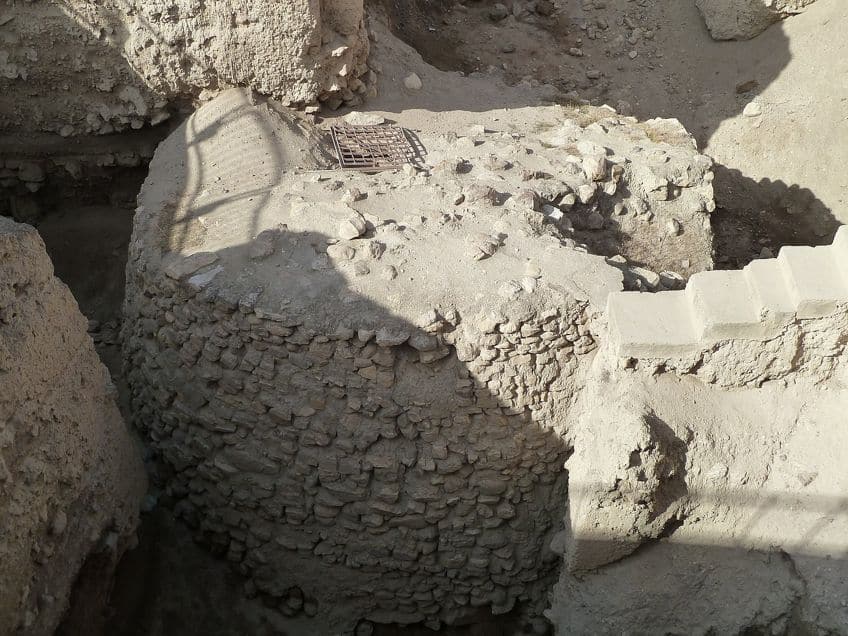
Göbekli Tepe (c. 9500 BCE)
| Date of Construction | c. 9500 BCE |
| Period | Pre-Pottery Neolithic period |
| Function | Temple |
| Location | Southeastern Anatolia, Turkey |
We have finally come to the oldest structure in the world, Göbekli Tepe. Layers of carved megaliths mark the site, which is thought to have been a ceremonial sanctuary. A multitude of T-shaped megaliths made of limestone, some of which exceed 5 meters in height and weigh up to 50 tons, are grouped in circular formations at Göbekli Tepe. Many similar formations are stacked on top of one another: once each finished circle was covered with soil, the procedure was repeated atop the same location.
While some of the megaliths are unadorned, others have complex patterns on their larger sides depicting scorpions, foxes, lions, and other animals.
It was examined for the first time in the 1960s but was disregarded as a medieval cemetery. It was rediscovered in the 1990s when its real age was determined by comparing the remains of artifacts unearthed at the site with those carbon-dated from surrounding sites. Most academics believe it was a ceremonial location that gathered pilgrims from long distances. Because the site’s remnants show that Göbekli Tepe was built by hunter-gatherers, some have questioned the link between settlement and social advancement.
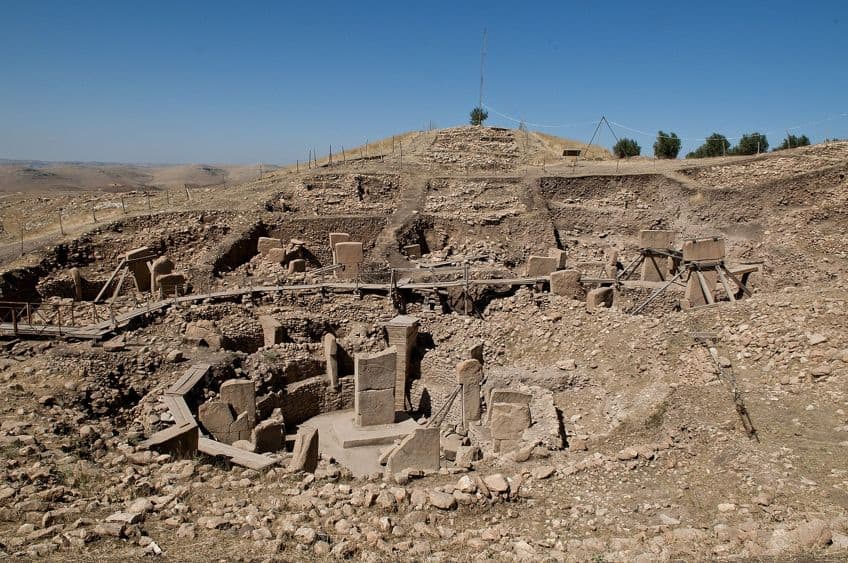
Knap of Howar (c. 3700 BCE)
| Date of Construction | c. 3700 BCE |
| Period | Neolithic period |
| Function | Farmstead |
| Location | Islands of Papa Westray in Orkney, Scotland |
The Knap of Howar, situated on the windswept island of Papa Westray in Orkney, Scotland, stands as a remarkable testament to ancient human habitation. Dating back to the Neolithic period, around 3700 BCE, it holds the distinction of being one of the oldest preserved stone dwellings in northern Europe. Comprising two adjacent structures, the Knap of Howar represents an early form of architectural innovation. These rectangular stone buildings, with their low, rounded walls, showcase the resourcefulness and skill of the Neolithic inhabitants. The structures are oriented with their long axes east-west, potentially indicating a connection to celestial or seasonal phenomena.
The dwellings were likely used for domestic purposes, serving as shelters for a community engaged in agriculture, animal husbandry, and fishing.
The inhabitants of the Knap of Howar were part of a society transitioning from a nomadic lifestyle to settled agricultural practices. The site’s preservation owes much to Orkney’s unique environmental conditions, which favored the survival of organic materials. Excavations at the Knap of Howar have unearthed a wealth of artifacts, shedding light on daily life during the Neolithic era. The discovery of stone tools, pottery, and even a figurine suggests a complex and culturally rich community. Today, the Knap of Howar stands as a tangible link to our ancient past, offering visitors a rare glimpse into the lives of early settlers who shaped the course of human history on the remote shores of Orkney.
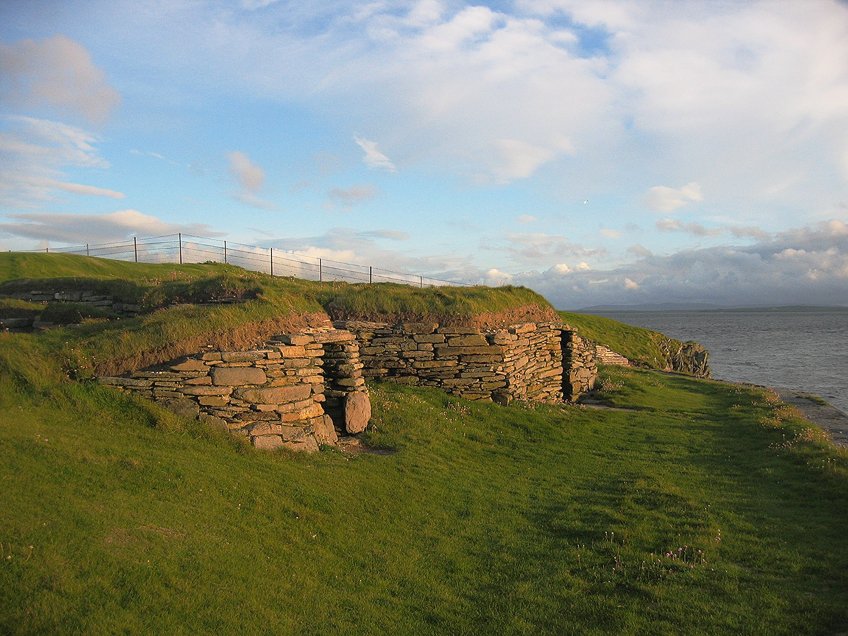
Newgrange (c. 3200 BCE)
| Date of Construction | c. 3200 BCE |
| Period | Neolithic period |
| Function | Temple |
| Location | County Meath, Ireland |
Newgrange, a prehistoric monument in Ireland, stands as a testament to ancient ingenuity and astronomical sophistication. Constructed during the Neolithic period around 3200 BCE, Newgrange is part of the Brú na Bóinne UNESCO World Heritage Site, which includes other remarkable passage tombs. The structure consists of a large circular mound with a central passageway leading to a chamber. One of Newgrange’s most remarkable features is its meticulously constructed roof box, positioned above the entrance. During the winter solstice, sunlight penetrates this box, illuminating the inner chamber for a brief period. This solar alignment showcases the builders’ advanced understanding of celestial events and their integration into religious or symbolic practices.
The purpose of Newgrange remains a subject of scholarly debate, but it is widely believed to have served as a burial site.
The elaborate carvings adorning the stones depict intricate spirals, circles, and other symbols, possibly representing a complex cosmology or religious beliefs of the Neolithic people. Over the centuries, Newgrange fell into disrepair and was forgotten until its rediscovery in the 17th century. Today, it stands as a captivating archaeological marvel, drawing visitors and researchers alike. Newgrange not only preserves the architectural and artistic achievements of its ancient builders but also offers a glimpse into the spiritual and astronomical insights of Neolithic Ireland.
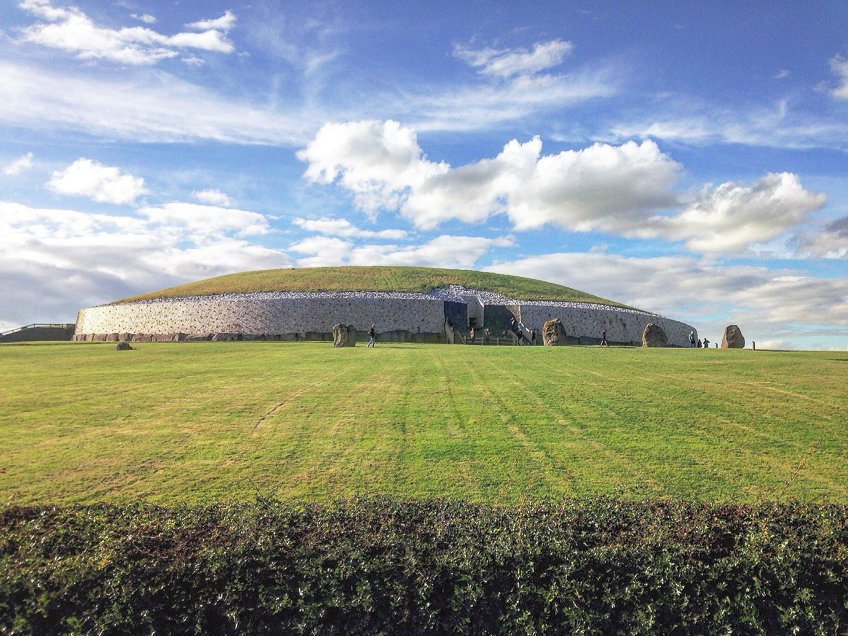
Uruk (c. 4000 BCE)
| Date of Construction | c. 4000 BCE |
| Period | Uruk period |
| Function | Settlement |
| Location | South of Baghdad, Iraq |
The history of Uruk is a tapestry woven with the threads of ancient Mesopotamian civilization, making it one of the most significant archaeological sites in human history. The city’s origins trace back to the Ubaid period (c. 5000–4100 BCE), but it was during the subsequent Uruk period (c. 4100–2900 BCE) that Uruk flourished into a monumental urban center. Uruk, located in southern Mesopotamia (modern-day Iraq), became a focal point of cultural and technological advancements. It was a pioneer in urbanization, featuring impressive architecture, including the iconic White Temple and ziggurat. The city’s expansion was accompanied by the development of the earliest form of writing, cuneiform script, employed primarily for administrative and economic purposes.
The city’s influence extended beyond its walls, and it played a pivotal role in the emergence of the Sumerian civilization.
Uruk’s societal complexity is evident in its stratified governance, with evidence of centralized authority and a priesthood associated with the city’s temples. Uruk’s prominence waned after the Uruk period, but it continued to be occupied and underwent subsequent transformations during the Early Dynastic and later periods. The legacy of Uruk endures in its contributions to the foundations of urban living, writing, and governance, shaping the trajectory of ancient Mesopotamian cultures and influencing civilizations that followed. Today, the archaeological remnants of Uruk provide invaluable insights into the dawn of urban civilization.
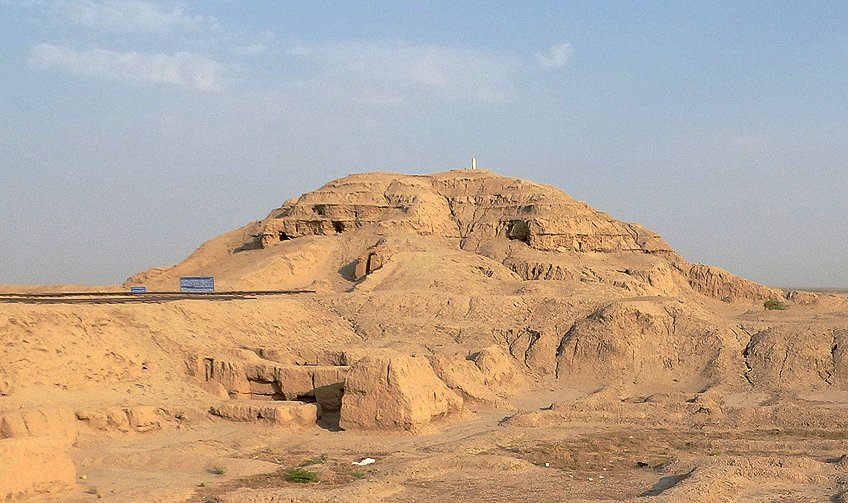
Stonehenge (c. 3000 BCE)
| Date of Construction | c. 3000 BCE |
| Period | Neolithic period |
| Function | Temple |
| Location | Wiltshire, England |
Stonehenge, an iconic prehistoric monument on Salisbury Plain in Wiltshire, England, has captivated human imagination for millennia. Constructed in multiple phases between 3000 BCE and 2000 BCE, Stonehenge stands as a testament to ancient engineering, astronomy, and religious practices. The monument’s primary feature is its ring of standing stones, each weighing several tons and arranged in a circular pattern. The exact purpose of Stonehenge remains a subject of debate, but it is widely believed to have served as an astronomical observatory and a ceremonial site associated with solstices and lunar events. Built by successive generations over centuries, Stonehenge evolved from a circular earthwork enclosure to the impressive stone structure we see today.
The precision of the stone placement suggests a sophisticated understanding of celestial alignments, possibly for calendrical or religious purposes.
Stonehenge’s cultural significance endured through various periods, evidenced by surrounding burial mounds and artifacts. In the Middle Ages, legends and folklore further enriched its mystique. In the 20th century, extensive restoration and research efforts shed light on its archaeological and cultural importance. Today, Stonehenge stands as a UNESCO World Heritage Site and attracts visitors from around the globe. It remains a symbol of ancient ingenuity and continues to inspire awe and curiosity about the mysteries of our distant past.
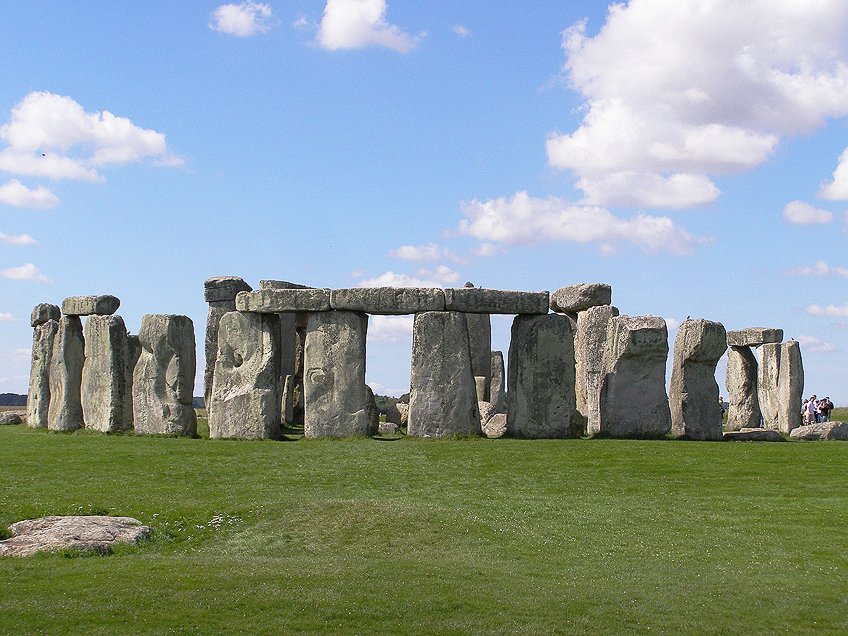
Pyramids of Giza (c. 2560 – 2500 BCE)
| Date of Construction | c. 2560 – 2500 BCE |
| Period | Bronze age period |
| Function | Temple |
| Location | Giza, Egypt |
The Great Pyramids of Giza, among the most iconic structures in the world, stand as enduring symbols of ancient Egyptian civilization. Constructed during the Old Kingdom, around 2580 to 2510 BCE, these monumental structures were built as elaborate tombs for three pharaohs—Khufu, Khafre, and Menkaure. The largest and most famous of the three is the Great Pyramid of Khufu, an architectural marvel composed of an estimated 2.3 million limestone blocks. The precision with which these massive stones were quarried, transported, and assembled continues to awe historians and engineers. The Pyramid of Khafre, slightly smaller but adorned with the enigmatic Sphinx, and the Pyramid of Menkaure, the smallest of the trio, complete the awe-inspiring Giza pyramid complex.
The purpose of these pyramids was not only as grand burial sites for the pharaohs but also as symbols of their divine connection and eternal afterlife.
The construction involved a massive labor force, likely including skilled workers, laborers, and engineers. The advanced knowledge of mathematics and astronomy displayed in their design, alignment with celestial bodies, and precision in construction highlight the ancient Egyptians’ profound understanding of science and spirituality. Over the millennia, the Great Pyramids have weathered the sands of time, standing as remarkable testimony to the ingenuity and cultural richness of ancient Egypt, drawing visitors and researchers alike from across the globe.
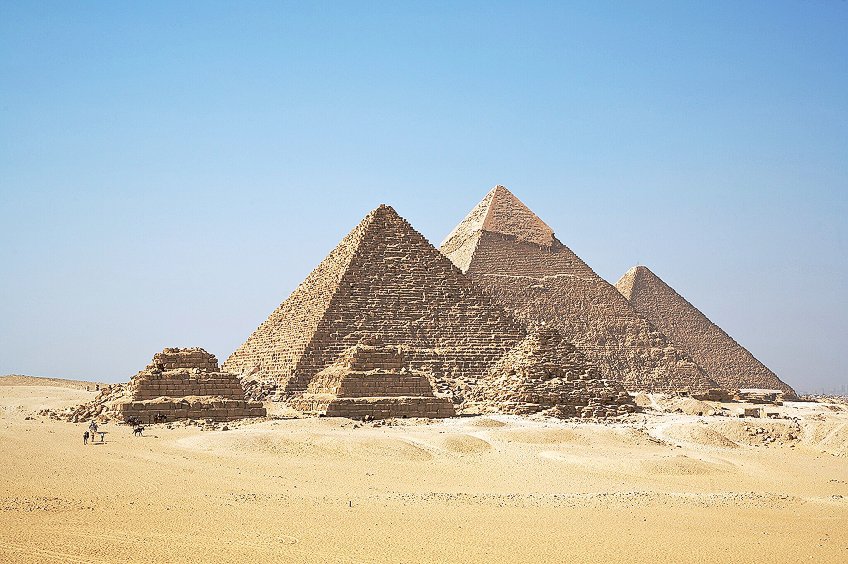
That concludes our look at the oldest buildings in the world. The oldest monument as well as the oldest structure in the world is Göbekli Tepe, created at a time when we previously assumed there were no settlements of this kind yet. Although thousands of years old, the oldest man-made structures featured on this list still display an incredible amount of skill and expertise, constantly making us reassess our understanding of the past and our own history as a species. The study of archeology and these ancient structures will help fill in the pieces of the story that have been lost to time.
Frequently Asked Questions
What Is the Oldest Building in the World That We Know Of?
The oldest man-made structure that we have discovered is Göbekli Tepe. It is thought to have been constructed beginning at some point around 9500 BCE. It was constructed during a period when man was still a hunter and gatherer. This has shifted the way we view the past, as we have always assumed that such places would only have been established once we had settled and started farming instead of while we were still nomadic peoples.
Where Is the Oldest Building in the World?
The oldest man-made structure in the world can be found in Turkey. Göbekli Tepe is located in southeastern Turkey in a region known as Şanlıurfa. It is located quite close to the border of Syria.
What Is the Oldest Wooden Building in the World?
The oldest wooden building in the world is believed to be the Horyuji Temple. That is not all though, as it is also one of Japan’s oldest temples still standing! It can be found in the ancient capital city of Nara, a renowned region worth exploring in itself.
Justin van Huyssteen is a freelance writer, novelist, and academic originally from Cape Town, South Africa. At present, he has a bachelor’s degree in English and literary theory and an honor’s degree in literary theory. He is currently working towards his master’s degree in literary theory with a focus on animal studies, critical theory, and semiotics within literature. As a novelist and freelancer, he often writes under the pen name L.C. Lupus.
Justin’s preferred literary movements include modern and postmodern literature with literary fiction and genre fiction like sci-fi, post-apocalyptic, and horror being of particular interest. His academia extends to his interest in prose and narratology. He enjoys analyzing a variety of mediums through a literary lens, such as graphic novels, film, and video games.
Justin is working for artincontext.org as an author and content writer since 2022. He is responsible for all blog posts about architecture, literature and poetry.
Learn more about Justin van Huyssteen and the Art in Context Team.
Cite this Article
Justin, van Huyssteen, “Oldest Buildings in the World – A Glimpse into 15 Ancient Wonders.” Art in Context. May 2, 2023. URL: https://artincontext.org/oldest-buildings-in-the-world/
van Huyssteen, J. (2023, 2 May). Oldest Buildings in the World – A Glimpse into 15 Ancient Wonders. Art in Context. https://artincontext.org/oldest-buildings-in-the-world/
van Huyssteen, Justin. “Oldest Buildings in the World – A Glimpse into 15 Ancient Wonders.” Art in Context, May 2, 2023. https://artincontext.org/oldest-buildings-in-the-world/.





